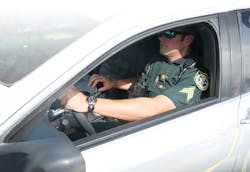Over the past two decades, mobile video has become indispensable to law enforcement and the judicial system. Among its many benefits, mobile video such as body-worn cameras (BWC) and in-car video (ICV) systems provide unbiased evidence in a courtroom, protect law enforcement departments against false or frivolous allegations and provide training opportunities for officers.
Compared to the earliest versions, today’s BWCs have drastically improved in weight, battery life, field-of-view (FOV), video resolution and overall video quality. Meanwhile, ICV systems have become an essential tool and accepted standard for evidence capture and officer situational awareness. Despite the benefits mobile video evidence provides law enforcement departments and communities, many agencies in the U.S. have yet to utilize one — or both — tools.
Here are five concerns law enforcement departments face when introducing or expanding a mobile video program.
Concern #1: Our officers already have body cameras. Do they really need ICV systems, too?
Body cameras have become a high-profile and important asset for police departments, but ICV still has inherent advantages over BWC as a foundational part of the evidence capture strategy. These advantages include having a controlled environment platform, a more consistent point-of-view, access to a stable power source, and access to multiple options for network connectivity. Evidence captured by ICV systems supports rapid closure of some of the most common cases, e.g., traffic violations and DUI/DWI. Today’s ICV systems also can improve situational awareness for officers. Some technologies that exist on the market today allow the body camera and ICV system to integrate, providing multiple related recordings and viewpoints in a unified evidence management platform.
Concern #2: Our agency has an older ICV system, which seems to have worked OK for us thus far. How can today’s ICV systems make a difference for our department?
Since their introduction in the law enforcement world, ICV systems have evolved tremendously. ICV systems today offer wider-angle coverage and higher-resolution video capture than systems of old. In fact, some systems available now use artificial intelligence (AI)-enabled human detection technology within the camera to automatically trigger recordings. This feature can be used to automate consistent recording of the passenger or transport area, reducing agency liability. For cameras directed externally, AI human detection can be enabled to sense a person is approaching the vehicle from a distance, triggering both an in-car video recording and an audible alert for the officer. This improves situational awareness by offering a view of all sides of the vehicle.
Although technology is constantly evolving, officer knowledge and safety should be of primary importance to all departments. Mobile video that is automated allows an officer to focus on their duties rather than the technology. A 360-degree FOV increases situational awareness, but only if it is incorporated into officer training correctly. “Situational awareness is invaluable, and any artificial intelligence that can detect a potential threat or alert me before I can see it is huge,” says Lt. Frank Borelli.
Look for ICV systems that have cameras with 1080p resolution and 150/180-degree FOV, as well as cameras that adapt to various lighting conditions.
Concern #3: Our department has several different technology providers for digital evidence. Wouldn’t it be a hassle to switch ICV or BWC systems?
ICV and BWC systems are not meant to last forever. Since technology changes and improves, there will come a time when your organization should reinvest in new, updated ICV and/or BWC systems. While one system may have worked for your department, it’s important to reevaluate your agency’s needs when it’s time to upgrade technology. Choose a manufacturer and products which support an open platform strategy including integration with third-party technology providers and services.
Concern #4: Our department doesn't have the time or money to manage digital evidence. How could a small department manage BWC and ICV data?
The challenges of managing mobile video data should not keep your agency from the significant benefits of this technology. Police departments must have a reliable digital evidence management system (DEMS) that can manage data from multiple sources. DEMS can improve investigation efficiency, link to external resources via a framework for sharing information and reduce department costs and officer time.
Concern #5: If we invest in new BWC or ICV systems now, the technology will just be obsolete in the next year or two.
Investment in technology is a big decision for every department. ICV technology has proven to have a relatively long usable life compared to other technology investments.
BWC technology, on the other hand, is likely to have a faster rate of change influenced by component miniaturization, communications technology advancements, battery advancements and video quality improvements. Organizations should plan for seven to 10 years of ICV system usage and three to five years for BWC usability.
When it comes to costs, agencies should consider financing options that support a sustainable technology strategy while allowing them to maintain control of their data now and in the future.
Sponsored by:








